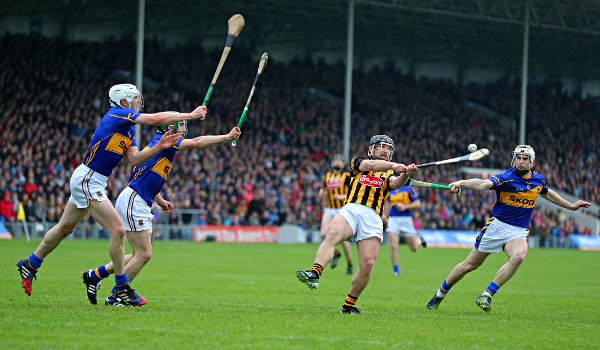AFTER Cork won last year’s Munster title, the outpouring of emotion which followed was completely understandable.
It was Cork’s first Munster title since 2006. It was the last big game in the old Pairc Ui Chaoimh. Cork avenged the previous year’s Munster final defeat to Limerick.
Most of all, Cork had real momentum again. There was a sense that the empire was finally striking back. Any talk of a rebel revolution though, came to a deadening halt five weeks later in the All-Ireland semi-final against Tipperary.
Almost 70,000 turned up, which constituted the biggest crowd ever to watch Cork and Tipp face off, but only one team really turned up. Tipp took a flamethrower to Cork’s ambitions.
It was their biggest win over Cork in the championship since 1965. The players and their manager left Dublin charred and blistered from the scorching.
“We let ourselves down,” said Jimmy Barry-Murphy about that experience before this year’s league final.
“Looking back on it, the five-week break was a major factor. If we were ever in that position again, I would use the time far differently. We had too much time together. We were doing the same thing over and over again. The players would have been far better off going back to their clubs for two weeks.”
Since the hurling qualifier era began 13 seasons ago, dealing with that five-week break has been a constant issue for the Munster champions. In eight of those 13 seasons, they have fallen at the All-Ireland semi-final stage.
Interestingly, in two of those five years when the Munster champions did advance to the final, they had only a three-week break because there were quarter-finals (which included the provincial champions) between 2005-07.
After Dublin and Limerick won breakthrough provincial titles in 2013, Anthony Daly met John Allen at a media event in Croke Park. Daly was quizzing Allen on Limerick’s approach. Allen was curious to know how Dublin were planning their preparations during the layoff.
They both seemed to agree that less might be better than more but neither was quite sure. In any case, Dublin and Limerick lost to Cork and Clare, who had come through the back-door.
The stats are even more pronounced when compared to how Kilkenny have mastered the art of timing that five-week run-in. Of the 13 All-Ireland semi-finals that Kilkenny have won in 15 seasons under Brian Cody, nine were secured after at least a five week layoff, with two more coming after All-Ireland quarter-final victories.
Kilkenny have been the modern standard. They have had the best players but Cody and his crew have also been experts at managing that extended layoff before All-Ireland semi-finals. And being able to replicate that template has been another part of the reason they’ve been able to get it right for so many All-Ireland finals.
After absorbing the harsh lessons of 2001, Kilkenny have mastered the lengthy lay-off because they’re so annually accustomed to it. In Munster, no one has enjoyed that privilege because no one has been that dominant.
Dublin’s emergence as a force, and Galway’s arrival into Leinster, made Kilkenny’s life more difficult in Leinster than it had been for most of the last decade but Kilkenny have still consistently been able to get their timing right.
When other teams were entering into August in that ideal groove of a game every two to three weeks, Kilkenny have still always been able to withstand that surge.
“Brian Cody has a system and a template in place now to deal with that five-week layoff which he knows works,” said Eddie Brennan recently.
“Guys go back to their clubs for a week, and then they build it back up again. It’s all about repetition. Everyone knows the drill. Psychologically, there is great comfort for the players in knowing that it works.”
Since Mick Dempsey arrived on the backroom team in 2006, Kilkenny’s preparations have been more measured and scientific. Training schedules were given six weeks in advance, with the proviso they were always subject to change.
They rarely did. And once Kilkenny arrived into an All-Ireland semi-final, the same routine was rolled out once more. Players were given their down time the week after the Leinster final.
If there were club matches, players were encouraged to fit in a couple of gym sessions to maintain the programme. With competition always hectic, and places up for grabs, nobody ever messed with the routine.
In the early years of Cody’s management, training weekends were a rarity. In 2000, the squad travelled to Clare, stayed in the Clare Inn and trained in Clarecastle.
Yet after Dempsey came on board, those trips were routinely built into Kilkenny’s schedule before All-Ireland semi-finals and finals. Initially, they travelled to Seafield in Wexford and trained in the Buffers Alley pitch.
Yet since 2010, they have located more to Carton House in Kildare. It’s where the Irish Rugby team train but part of the reason Cody chose to use that base was because the pitch was similar in size and surface to Croke Park.
On Sunday, Waterford arrive into Croke Park with momentum and confidence. Since April, they have played five big games. In the same timespan, Kilkenny have played two. Waterford have had two huge games in the last month to prepare themselves. Kilkenny have had none.
And yet to win on Sunday, Waterford are going to have to crack a code that Kilkenny have mastered.


